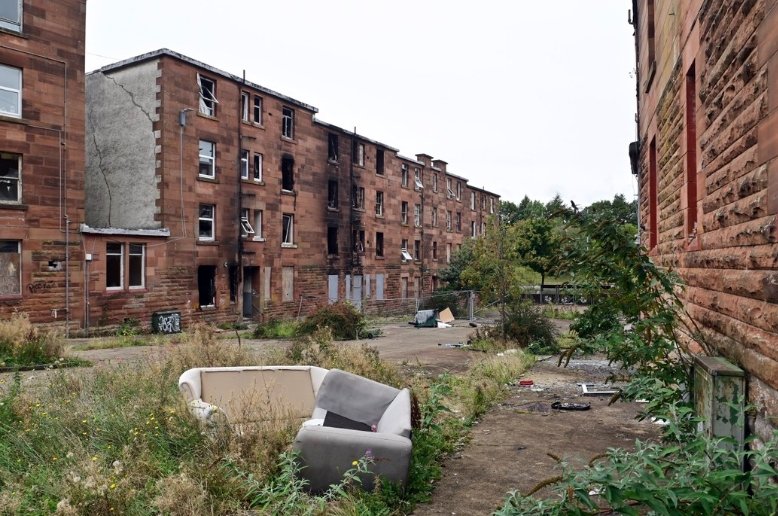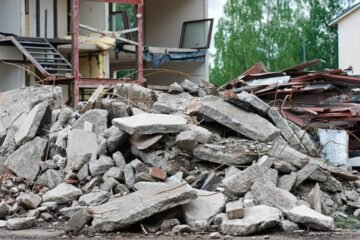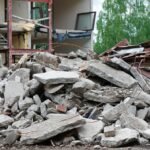They rise like relics of a forgotten era—rows of crumbling tenement blocks, boarded windows, graffiti-tagged walls, and overgrown closes. For decades, the Clune Park estate in Port Glasgow has been compared to the abandoned Ukrainian city of Pripyat. Now, after years of legal wrangling and decay, demolition crews are finally preparing to flatten parts of what’s long been dubbed “Scotland’s Chernobyl.”
A Legacy of Shipyards and Sandstone
Built in the aftermath of World War I by shipbuilding giant Lithgows, Clune Park once stood as a proud symbol of Scotland’s industrial might. At its peak, the estate provided tightly packed housing for shipyard workers on the lower Clyde—a network of 430 modest flats radiating from Robert Street in red sandstone grandeur.
“It was lovely—the neighbours were nice. It was very friendly—everybody knew everybody,” recalls former resident Karen Thomson, who moved into Wallace Street with her husband in 1992.
Back then, Port Glasgow thrummed with life. Schools, shops, and churches punctuated the compact community. The Clune Park Church, with its Art Nouveau window and stone tower, served as a spiritual and social anchor for generations.
But industry changed. Shipyards closed. Families moved on.

From Community to Collapse
As the economic tides turned, so too did the fate of Clune Park. By the late 1990s and early 2000s, the area had become a magnet for private landlords and buy-to-let schemes. Many properties were snapped up cheaply, then poorly maintained—or left to rot altogether.
“The area started to fall down,” said Karen. “They weren’t keeping up maintenance. The area just started going to pot.”
What followed was a spiral of decline. Rents fell. Vacant flats multiplied. Property values plummeted. By the 2010s, the estate was riddled with drug issues, crime, and neglect. Entire blocks sat empty. Graffiti crept across walls like ivy. Fires ravaged both school and church buildings.
Still, legal deadlock between Inverclyde Council and dozens of scattered landlords stalled any substantial redevelopment. For years, the estate existed in limbo—a silent, unsettling monument to stagnation.
A Playground for Urban Explorers
In its eerie abandonment, Clune Park found a strange second life online.
Urban explorers, photographers, and YouTubers began flocking to the site, drawn by the desolate beauty of decay. Images of shattered stairwells, moss-covered tiles, and doorways opening into voids proliferated on Instagram and Reddit. The estate’s dereliction, coupled with its century-old architecture, invited inevitable comparisons to the ruins of Pripyat.
But while Chernobyl’s emptiness was born of nuclear disaster, Clune Park’s stemmed from economic erosion and policy gridlock.
That hasn’t stopped the nickname “Scotland’s Chernobyl” from sticking. Nor has it prevented thrill-seekers from breaching fencing and ignoring warning signs.
“It’s dangerous,” says a council spokesperson. “These buildings are structurally unsafe. We’ve had to increase patrols and issue multiple public warnings.”
The Bulldozers Arrive
Now, after years of waiting, the first concrete steps toward dismantling Clune Park have begun.
Demolition contractors are expected on site within days to bring down approximately a third of the estate, starting with the most hazardous structures. This includes the shell of the fire-damaged primary school, and the graffiti-covered Clune Park Church, which has stood roofless and hollow for years.
The move comes after structural assessments deemed these buildings a risk to public safety. While the entire estate won’t disappear overnight, the initial demolition is seen as a long-overdue step toward finally addressing a civic wound that has festered for more than two decades.
What Comes Next?
Inverclyde Council says it remains committed to acquiring more properties, clearing the site, and eventually transforming it into “an area the community can be proud of.”
But regeneration won’t be easy—or quick. Ownership remains fragmented, legal challenges abound, and questions persist about what can realistically replace the housing stock lost.
Still, for many, just seeing heavy machinery rolling in offers a flicker of hope.
“It breaks your heart to see what it’s become,” said Karen. “But maybe now something better can finally rise from it.”
Ghost Town No More?
Whether Clune Park will soon be reborn or remain a patchwork of demolition and delay remains to be seen. For now, at least, the era of eerie stillness appears to be ending. The walls that once housed generations of workers, families, and dreams are coming down—brick by brick, floor by floor.
And as the dust rises, so too does the hope that Port Glasgow may finally move on from the shadow of its forgotten estate.


















